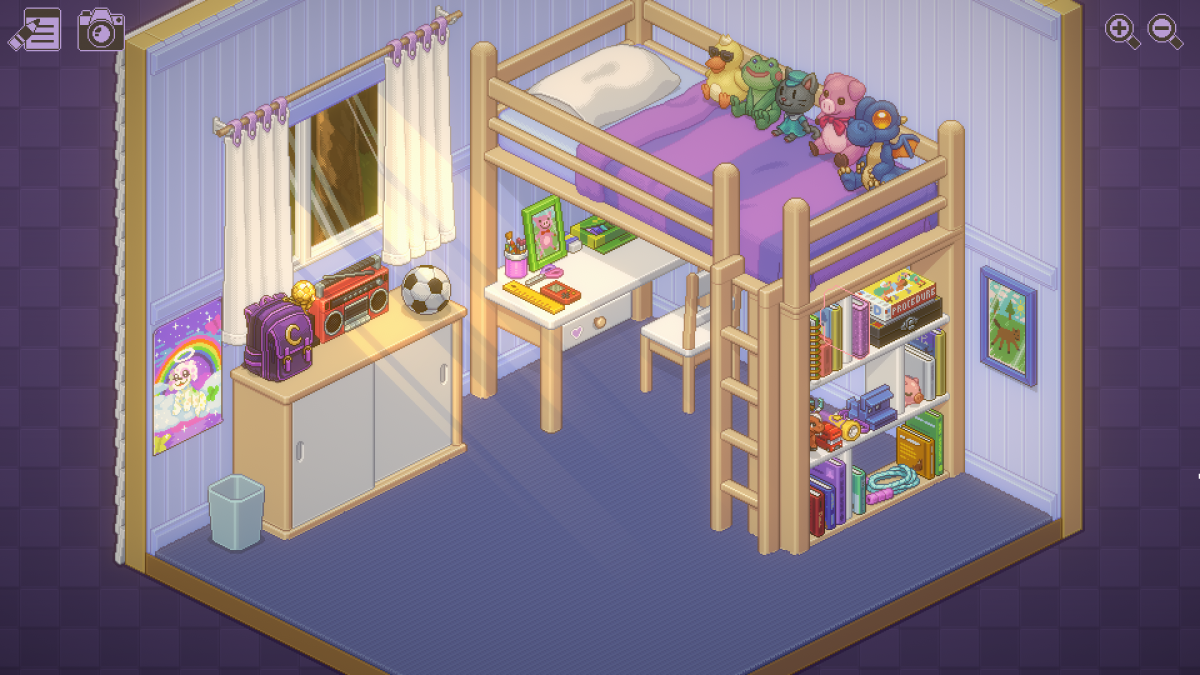Looking for the Quick Review?
Unpacking is a game about (can you guess?) unpacking. Following one unnamed protagonist through a series of moves that start with her childhood bedroom and end at her first house, your job is simple: take things out of boxes and put them where they belong. Where? You decide. I mean, mostly. At the end of each unpacking, item placements that fail to satisfy our main character are outlined in a blinking red. It initially feels like an odd way of doing things (I put the toaster in the sink for a reason. It’s better that way, you just need to learn) but I found it ended up solidifying a puzzle game backbone that made the creative play-how-you-want part of the game more meaningful.
I think the developers imagined I’d play the game from the perspective of its protagonist. I tried that at first. But the blinking red outline on the items I’d misplaced felt more like the corrective feedback of a second person than my own acknowledgment of my mistakes. This allowed me to distance myself from the dissimilarities between myself and the character, but more importantly, it allowed me to never acknowledge my mistakes. Again, there’s no reason underwear shouldn’t go under the bed. I’ll move it, but only because you asked nicely.
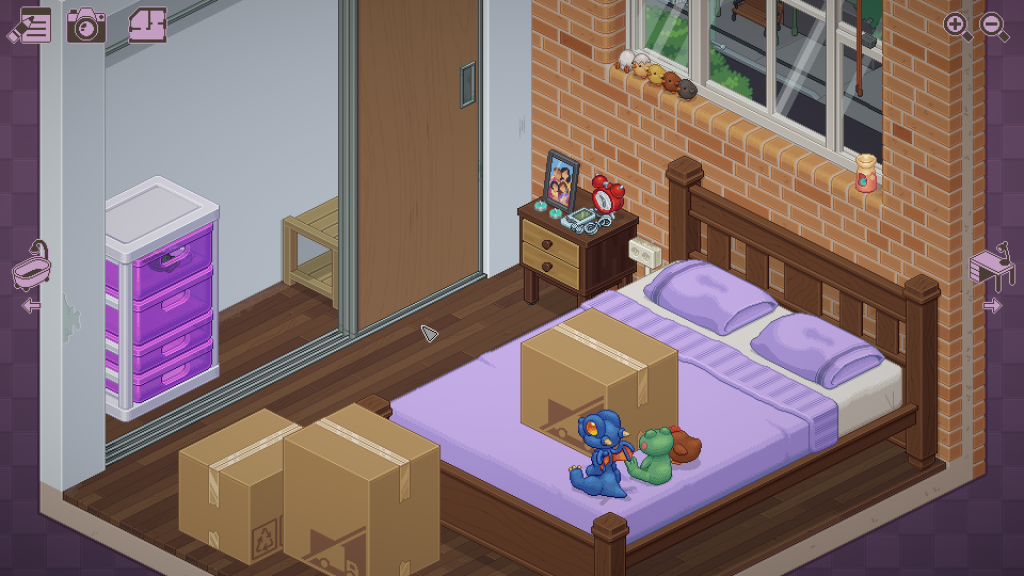
The beauty of Unpacking wasn’t in the rooms I designed, but the lives I ended up experiencing. The first time I opened up a box and started shoving things into whatever corner they’d fit into, the items meant nothing to me. Sure, the stuffed animals were cute and the toys neat, but they weren’t mine. Then, slowly, a story bloomed. I’d complete one level and move onto the next, set a few years later. I’d open a new box to unpack those same stuffed animals, a familiar toy, a poster I’d hung twice already. I started looking around my own living room, beyond the screen, taking inventory of the items I’d kept; a table I ate dinner off of in college that later spent a few years as a neglected printer stand. Now it holds some of our plants. Across the room, a bedroom bookcase/nightstand plays host to our TV. Our belongings tell a story.
Each unpacking offers us a window into the unnamed protagonist’s life, both past and present. Our part is minimal, we may as well be movers hired for the day. We don’t get to see any of the important events in our main character’s life; we don’t actually see her at all, not directly. But the act of unpacking starts to feel like we’re taking part, experiencing with her. I’ve lived in my own house for years, but I can’t help getting a little excited by the opportunity to live briefly again as a child designing my first bedroom. Going from that to the protagonist’s first college dorm, I feel that surge of independence and freedom, as much as the idea of actually going back to a cramped and sweaty residence hall would throw me into panic any other time.

Moving her into her first apartment with roommates is equally exciting. We get to relive the experience of negotiating common space without living through the guaranteed conflict. After a couple of years there, we arrive again to help our friend move into her new partner’s apartment, a small but sleek highrise unit. I love the aesthetic, but in this context, there’s something off-putting about it. For the first time, our protagonist’s own character doesn’t shine through, taking a far back seat to the established theme of someone else’s dwelling. With the boxes almost empty, I unpack her framed college degree, previously hung proudly above her desk. Here, there’s no space for it, the walls already neatly-adorned. We settle for a spot under the bed. The way I write about it, it sounds like the relationship was doomed from the start. Text affords us that perspective. Seeing the place for the first time, exploring the rooms, doing the unpacking, it doesn’t feel like that at all. The excitement brought on by the luxury and novelty clouds that judgment.
Of course, the pair don’t last, and for the first time in our protagonist’s life, she experiences a downgrade and moves from this elite suite back into her childhood bedroom. From the outside, we view it as a temporary setback; I hastily unpack the few boxes on the ground and put everything where it fits, rather than where it goes. I don’t hesitate to find a place for all of her photographs on a corkboard hung on the wall. When I’m done, she (through the lens of the game) points at them and lets me know I’ve made a mistake: the one with her and her boyfriend. It doesn’t belong there. I hide it away in a cabinet. That’s better. While I’m there, I spot a rolled-up poster, one from the first move, when she was a kid. I unroll it and throw it back on the wall. I don’t know if you can ever really go home again. But I do know you can visit.
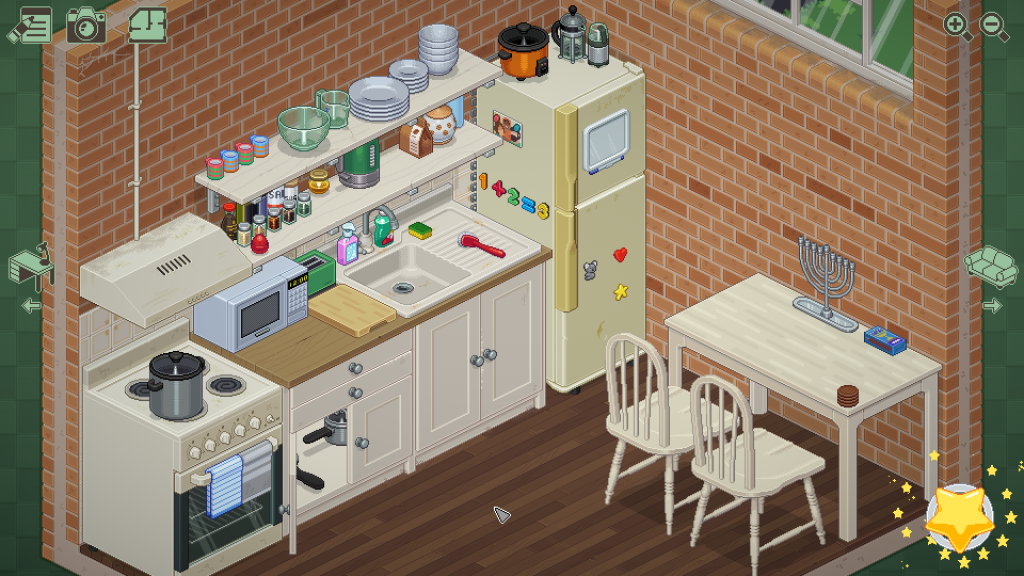
Eventually, our friend lands back on her feet and finds a new place of her own. It’s a little rough around the edges, and it’s no luxury penthouse, but it’s hers. There’s a comfort to this place, a feeling that comes from having followed her through her last move. Things are okay. Everything’s going to be alright. This unpacking feels more permanent. We see more familiar items, from childhood and from college. For the first time in years, our protagonist has a place that feels like it’s her own.
And then it’s not. The next move might be my favorite. It’s not hers. We walk into the same unit. Most of the things are right where we left them, with a few important exceptions. The pair of ragtag bean bag chairs plopped down in the living room have been evacuated to make way for a real couch. Some of the items, including some she’s had for years, have also been replaced with superior models. But we’re not just visiting. There are boxes everywhere, just, for once, not hers. She’s invited a new partner into this space. It feels different from last time. Their styles don’t clash as much. They have shared interests, like books, and they both love stuffed animals. The new inhabitant seems nerdy in her own way; she’s a big film junkie. We unpack all her stuff, find places to put it. I leave feeling hopeful. I want them to do well together.
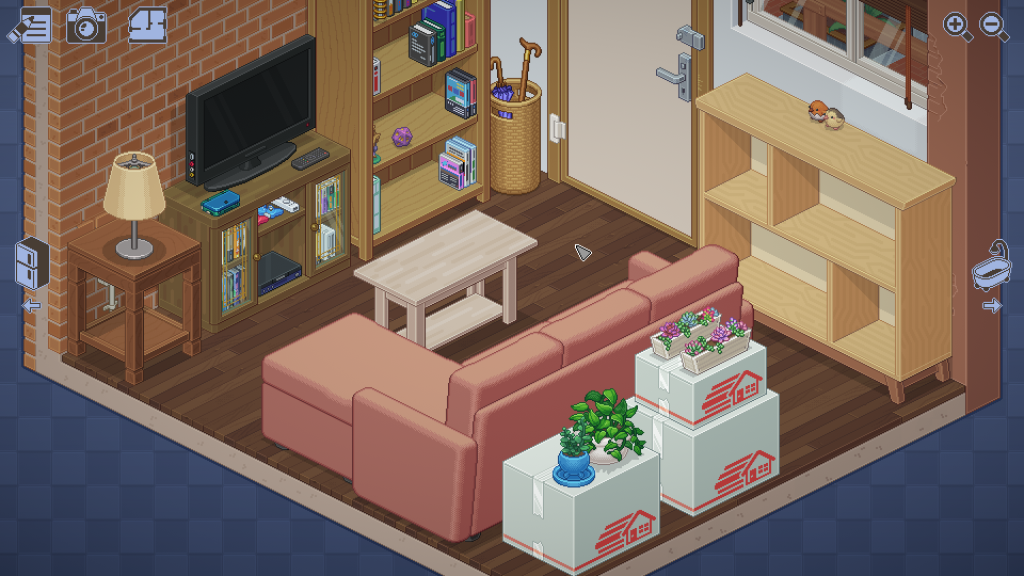
The next time I see them is the last. Does that sound morbid? They’re fine; great, actually. This is just the last time they’ll need my help. This place is permanent. One last time, I unpack their things, the protagonist’s, the stuff I feel like I’ve known forever, her partner’s, which I’ve started to grow familiar with, and then everything they’ve collected together. They share some trinkets, and they’ve started to develop a shared style. They feel like a family. But maybe that’s the baby. There’s a sense of wholesomeness and accomplishment. Unpacking the first room, I put a set of markers on the table. Now, I’m finding a place for an artist’s tablet and an easel on a crowded desk. Behind it, a bookshelf housing some eight or so copies of a beautifully-illustrated children’s book. I’m embellishing; it’s, like, a picture of a pig. But I feel a responsibility to hype up my friend. She’s clearly worked hard and done a great job.
When I lean back and look at what I’m doing through a (shittier) more objective lens, I realize I’m just decorating a make-believe space. But that’s not how it feels. The house isn’t just real, it’s earned. Our protagonist worked to get here, suffered setbacks, rebuilt. She met someone she loves. They started a family together. The house is whatever — actually, it’s not; it looks really, really good because the solo unpacker was extraordinarily talented — but the story is meaningful, worthwhile, complete.
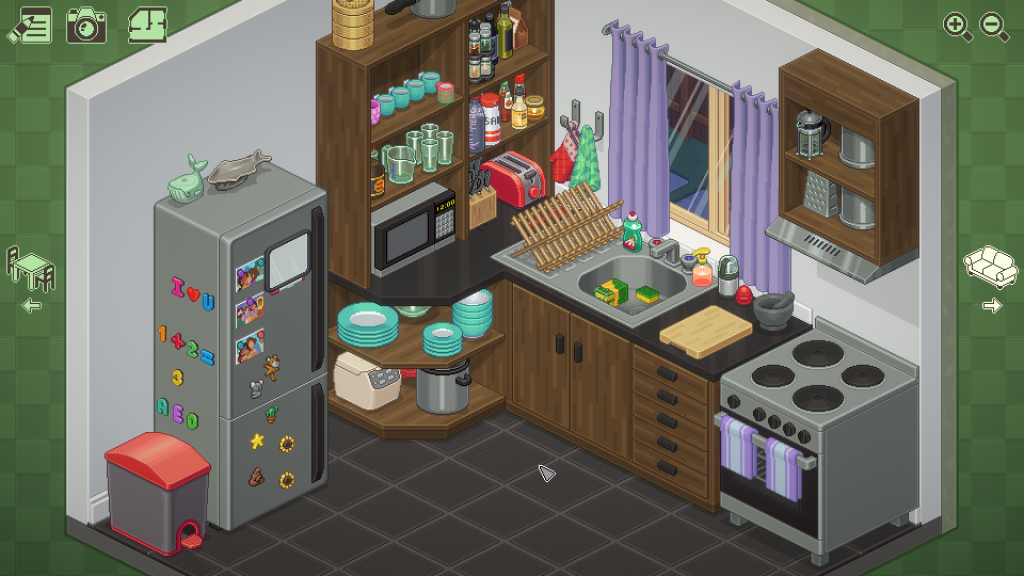
I came here to play a puzzle game about unpacking boxes. I was hopeful, given my penchant for games that allow for creative solutions. But I was hesitant, too, given my near-hatred for the act of putting things into boxes only to pull them back out days later. I don’t like moving. Does anyone? This game isn’t really about moving, though. I mean, obviously it is, but the real value is the lives lived between the lines, the people behind the trinkets and furniture.
This is one of the sappiest reviews I’ve written for a video game. The last one of these I finished was for The Witcher, a game that let me tear the limbs off of grotesque and horrifying monsters. This game had me unpacking boxes. It was short; I ended up beating it in just a few sittings. But it was cozy, fulfilling, and heartwarming. I’ll get into the quick review below, but if you made it this far, I’ll be a little quicker: if any of this made the game sound intriguing to you, give it a shot. If you entered confused and you’re still there, this is probably a miss for you. Unpacking is a treat for the sentimental and for those of us who find joy in reading a story from context. It’s a very simple game, and I enjoyed it a lot.

Quick Review
Game: Unpacking
Developer: Witch Beam
Published by: Humble Bundle
Available for: Microsoft Windows, macOS, Linux, Nintendo Switch, Xbox One
CONTENT
Microtransactions: None
Tedium: Little (Entirely dependent on how much you enjoy unpacking boxes)
Violence: None
Content: Emotions

FEATURES
- Cute, pixelated home design
- Relaxing gameplay
- A neat li’l story
WHAT I LIKED
- Art: I’m a sucker for high-resolution pixel art. The game’s art style won me over quick and kept me for the rest of the game.
- Cozy: This is a relaxing game. Sure, the protagonist’s packing style can be slightly infuriating at times (a pair of socks in every box? Really?), but the fury subsides as the chill vibe of the game returns.
- Story: I imagine it’s hard for a game this short and simple to have such a compelling narrative, but it does. It’s rewarding to watch a character we come to know experience life, either as we have or as we might want to. It’s cathartic in the most positive way.
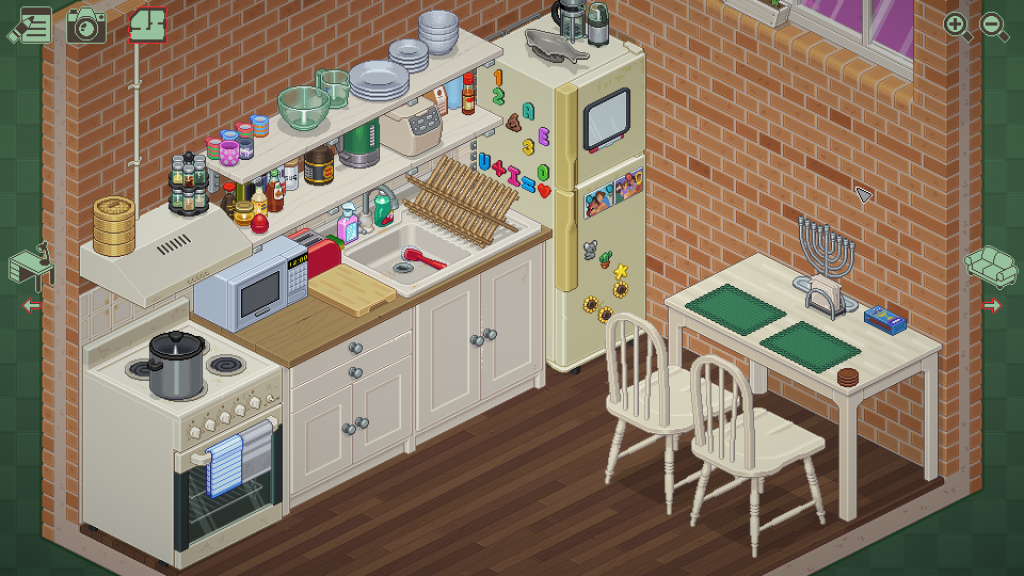
CONCERNS
- Time: Unpacking is a very short game. I completed it over a few play sessions. Dedicated players could easily steamroll through in one. With a game like this, though, I usually maintain it’s more about the experience than the hours. It’s a perfect Game Pass game (and it’s on Game Pass right now).
- Simplicity: In the longform review above, I compared some of Unpacking‘s mechanics to those found in puzzle games. It wouldn’t be too much of a stretch to call this a puzzle game, but it’s certainly not a traditional one. You won’t rack your brain thinking of definite solutions. Most of the difficulty is player-imposed; if you can stomach keeping the crock pot out on a table instead of finding a permanent home for it, you’ll breeze through. The prettier you like things, the more challenging it is.
WHO’S IT FOR?
From the long review above:
if any of this made the game sound intriguing to you, give it a shot. If you entered confused and you’re still there, this is probably a miss for you. Unpacking is a treat for the sentimental and for those of us who find joy in reading a story from context. It’s a very simple game, and I enjoyed it a lot.

